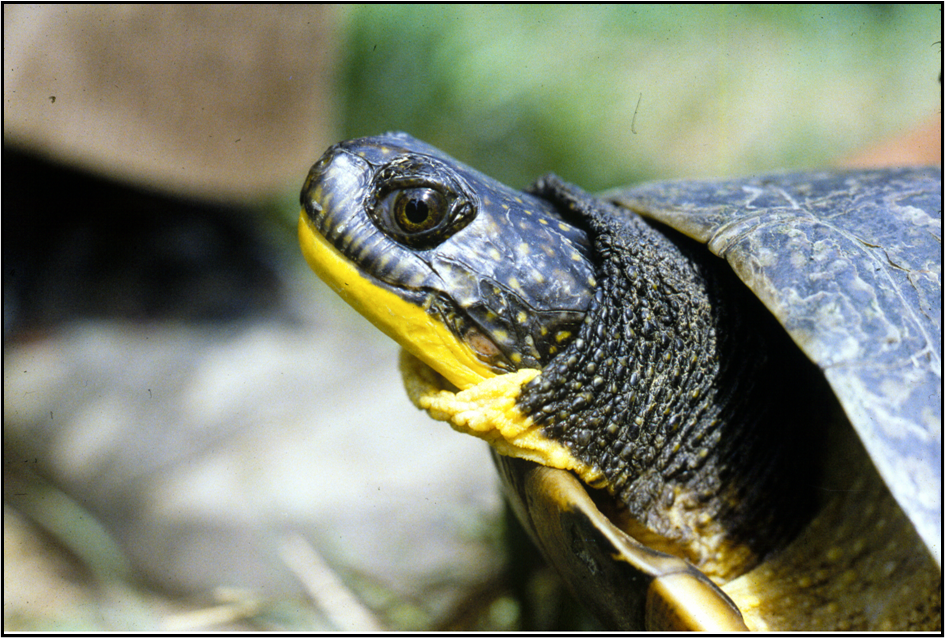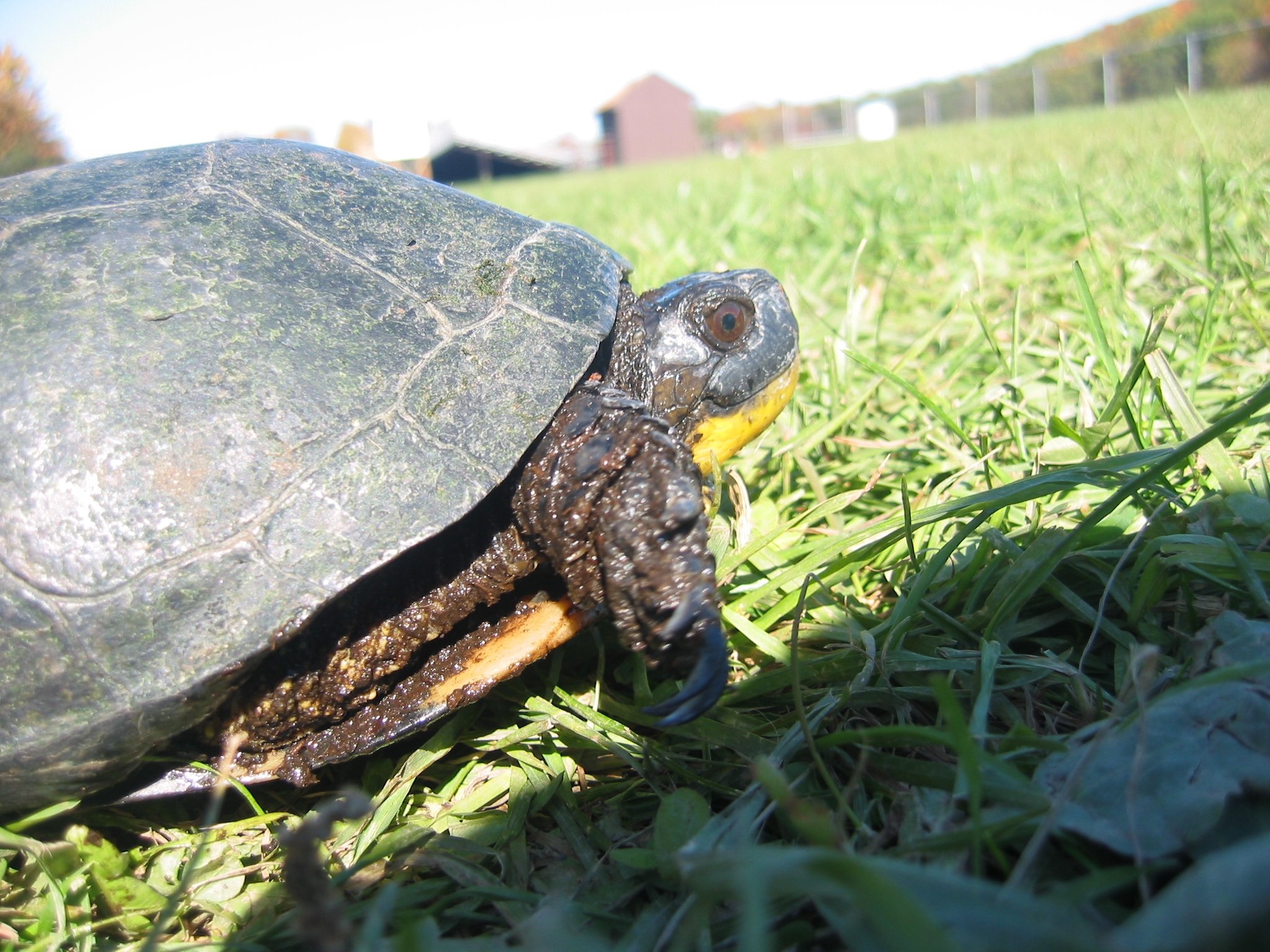What’s so special about the Blanding’s Turtle
The Blanding’s turtle is considered endangered, threatened, or a species of concern in almost every state or province in its range, which centers on the Great Lakes and includes 16 states and Canadian provinces. In New York, the Blanding’s turtle is officially listed as a Threatened species and occurs only in Dutchess County and in a few counties in northern New York. It is red-listed by the International Union for the Conservation of Nature as endangered.
All species play a role in their environment, and we are all interconnected. The decline or disappearance of a rare native species,particularly one that uses a variety of wetland habitats, can indicate the collapse of the local ecosystem, which supports not only many other animals but humans as well.
Their benefits to humans are not just ecological; Blanding’s turtles have proven useful in medical and biological research. For example, the Blanding’s turtle is able to reproduce throughout its long life, and study of this phenomenon may help researchers better understand the aging process in other animals and in humans. In addition, the isolated populations in the Northeast, such as those in Dutchess County, are genetically different from populations in the Great Lakes region. This has important implications for their conservation in Dutchess County and their potential value to research.
Natural History
Blanding’s turtles use a variety of special habitats, which are often damaged by human activities in our rapidly suburbanizing region. Blanding’s turtles usually spend the winter below the ice in shrubby swamps. They survive the cold temperatures and low oxygen levels by greatly reducing their metabolic activity—so much that, even though turtles are air-breathing animals, they obtain the oxygen they need to survive through their digestive tracts.
As spring approaches, the turtles become more active and venture out to find food and warmer water temperatures.Often, they leave their winter wetland to take advantage of abundant food or warm water in other wetlands, such as marshes or woodland pools. By late summer, many turtles have moved to deeper water bodies, which serve as “drought refuges.” This habit of moving among different wetlands during the year increases the turtles’ vulnerability to human-related hazards such as busy roads, intensively developed areas, agricultural fields, and collectors.
The females are particularly vulnerable to these hazards in June when they travel long distances, often more than half a mile, to find a suitable nesting place. They frequently rest in wetlands or other water bodies during their journey to and from the nesting site.The females take great care in choosing a nest site, often spending a week or longer in their search.Nest sites are usually in open, well-drained areas such as agricultural fields, lawns, and gravelly road shoulders.Once she has found the “perfect” spot, the female spends many hours (3-7 or more) digging a hole, laying her clutch of 5 to 17 eggs, and then covering it—all under the shelter of night. She then returns to the water, never to know the fate of her eggs or young.
The hatchlings emerge from the nest in late summer and make their way to a nearby wetland.Many eggs and hatchlings are lost to predators, which include skunks, raccoons, foxes, and dogs. These animals thrive in suburban areas, adding to the pressures on turtles.After their first or second year, however, the turtles develop a hard shell, which protects them from most predators.Barring interference from human-related hazards such as habitat loss and encounters with vehicles, most Blanding’s turtles live a long, productive life, reaching maturity at about 15 years and breeding until they die, at about 70 years. The oldest known Blanding’s turtle was 80.
How to Identify a Blanding’s Turtle
The adult Blanding’s turtle has a dark, helmet-shaped carapace (upper shell), which can be up to 10 inches long. The light speckles that adorn the carapace and head are most visible when the turtle is wet. The plastron (undershell) is cream or yellow with dark blotches. A hinge across the center of the plastron allows the turtle to partially close its shell. The most striking feature of the Blanding’s turtle, and the one that distinguishes it from all other North American turtles, is the bright, solid yellow color of the chin and throat.
What You Can Do!
Ultimately, the conservation of Blanding’s turtles in Dutchess County will require protection of wetland and upland habitat complexes that can accommodate the various needs of the turtles.These complexes must include different kinds of wetlands for overwintering, foraging, juvenile habitat, and refuge from drought, as well as suitable upland nesting sites and safe corridors for travel between habitats. The suburbanization of Dutchess County need not result in the loss of any wildlife species.In the case of the Blanding’s turtle, we have the opportunity to protect existing habitat through low-cost planning measures—such as restricting new road construction and locating development away from Blanding’s turtle wetlands and nesting areas—before restoration becomes necessary. Encourage the Planning Board and Conservation Advisory Council in your town to incorporate Blanding’s turtle habitat protection measures into their planning and decision-making.Hudsonia has prepared a set of maps of potential Blanding’s turtle habitat in southern Dutchess County to assist in the planning process.
Meanwhile, anyone living within the range of Blanding’s turtles in Dutchess County can take steps in their everyday life to help protect the turtles. For example:
During the warm season (May-September), check for turtles underneath your parked car before driving.
Drive carefully to avoid accidents with turtles and other wildlife.If you see a “rock” in the road, slow down—it may be a turtle! When you encounter a turtle on the road, stop and move it off the road in the direction it was heading. Do not take it home or move it more than 100 yards. Be careful not to endanger yourself in traffic.
Watch for turtles when mowing or using motorized equipment, especially during the June nesting season when Blanding’s turtles may be traveling long distances overland.
Eliminate pitfall hazards such as abandoned swimming pools, open excavations, window wells, ditches, and unscreened storm drains which can trap turtles and other small animals.
Alter vertical barriers such as stone walls, stockade fences, or chain-link fences so that turtles can pass under them.
Do not take turtles home with you. Protect turtles from collectors, and help to educate would-be turtle collectors. The New York Environmental Conservation Law imposes a fine of up to $1000 per occurrence for collecting without a permit, harassing, or killing a Blanding’s turtle.
Protect wetlands, streams, and upland areas from drainage, channelization, filling, dumping, pollution, and other damage. It is illegal to modify any wetland known to be used by Blanding’s turtles.
If you are considering modification of a property within the Blanding’s turtle range in Dutchess County, consult the regional office of the DEC Bureau of Wildlife in New Paltz (845-256-3089).
If you would like more information about what you can do to protect Blanding’s turtles, contact Hudsonia (845-758-7053).




